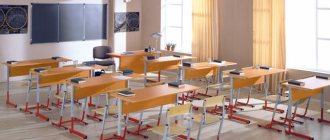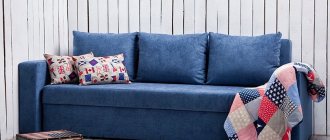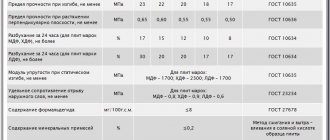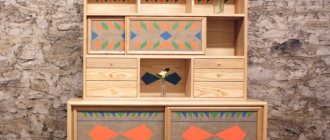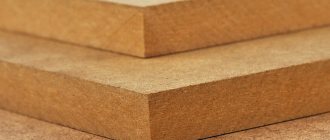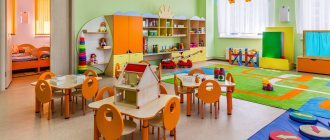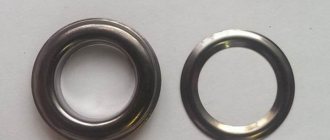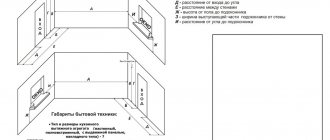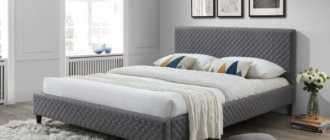All educational institutions need quality furnishings. According to the standards prescribed in the legislation of the Russian Federation, any piece of furniture used in a school must meet safety and comfort standards. Their parameters must correspond to the child’s growth, which is especially important for the primary grades, since in this period children grow quickly. The production of these products is carried out in compliance with all laws, thanks to which the educational process proceeds without any violations of posture, vision and other health problems. Below is information about the marking of furniture (desks and tables), its sizes in the table according to Sanitary Regulations in elementary schools.
Requirements
Standardized labeling indicators are specified in the regulatory document GOST 22046-2016 “Furniture for educational institutions. General technical conditions". This standard was approved by the Interstate Council for Standardization and is applied throughout Russia. According to this legislative draft, the bulk purchase of student equipment is permitted, which has undergone a preliminary strength test, taking into account the relevant documentation.
Furnished products for student use must have the following parameters:
- The gloss of the coating is no more than 49%.
- The working surface is easy to clean from dirt. Science classroom tables are equipped with a protective layer against chemicals.
- Compliance with all epidemiological standards.
The dimensions of educational furniture and its marking at school (according to SanPiN) are far from the only conditions that must be met. Requirements are also put forward for assembly:
- Reliable fixation of all structural parts.
- Impossibility of manually separating hardware elements.
- The absence of any irregularities on the outer surface. Sharp edges are rounded and holes in metal pipes with a diameter greater than 7 mm are closed or hidden.
- Contaminating parts are hidden.
GOST 22360-95 regulates the proper fixation of large objects:
- A strong and immovable connection of all parts of the structure and the impossibility of disassembling it manually.
- Reliable fastening of the stand (if available) to the object.
Furniture used in educational institutions must have special markings, which are indicated in Russian or the official regional language. It is prohibited to make any marks on the work surface. Tables are marked using special colored stickers that correspond to the height categories of GOST 11015 and 11016.
Lid level standards
To determine the standard dimensions of a desk for a schoolchild or an adult, manufacturers use the relevant regulatory documents. The dimensions of the furniture depend on its design and purpose: tables can be straight, corner, or adjustable to suit the child’s age.
The distance from the floor to the top board, the length of the lid, the depth of the under-table space - these values characterize furniture for paper work. Its main parameter is the height of the desk, which is selected according to the person’s height.
Height is the main parameter of a desk.
Desk number (according to Sanitary Regulations) and the size of educational furniture according to the student’s height, table
Experts have developed a size table that provides for the division of furniture into 6 groups. Such a classification makes it possible to differentiate it depending on the growth of children, thanks to which they can sit safely and comfortably at tables without damaging their eyesight or posture while doing any work (reading, writing, drawing and much more).
Excess of surface above the floor for an adult
For a straight layout or a corner cover model, the level of the top surface is the same. According to the standard, a desk in a house can have different heights. It depends not only on the user’s height, but also on the accessories placed on the tabletop:
- size according to GOST for the height of the lid for drawing and writing – 72-78 cm;
- office equipment installed on top is a reason to reduce the lower limit of the distance to 650 mm;
- world practice: with a height of 1.5-1.6 m - height 60 cm, 1.75-1.83 - 70-80 cm, 1.9-2 m - 85-90 cm.
A desk for an adult has its own parameters.
The comfortable level of the tabletop for children's furniture is different.
Ready-made solutions for all areas
Stores
Mobility, accuracy and speed of counting goods on the sales floor and in the warehouse will allow you not to lose days of sales during inventory and when receiving goods.
To learn more
Warehouses
Speed up your warehouse employees' work with mobile automation. Eliminate errors in receiving, shipping, inventory and movement of goods forever.
To learn more
Marking
Mandatory labeling of goods is an opportunity for each organization to 100% exclude the acceptance of counterfeit goods into its warehouse and track the supply chain from the manufacturer.
To learn more
E-commerce
Speed, accuracy of acceptance and shipment of goods in the warehouse is the cornerstone in the E-commerce business. Start using modern, more efficient mobile tools.
To learn more
Institutions
Increase the accuracy of accounting for the organization’s property, the level of control over the safety and movement of each item. Mobile accounting will reduce the likelihood of theft and natural losses.
To learn more
Production
Increase the efficiency of your manufacturing enterprise by introducing mobile automation for inventory accounting.
To learn more
RFID
The first ready-made solution in Russia for tracking goods using RFID tags at each stage of the supply chain.
To learn more
EGAIS
Eliminate errors in comparing and reading excise duty stamps for alcoholic beverages using mobile accounting tools.
To learn more
Certification for partners
Obtaining certified Cleverence partner status will allow your company to reach a new level of problem solving at your clients’ enterprises.
To learn more
Inventory
Use modern mobile tools to carry out product inventory. Increase the speed and accuracy of your business process.
To learn more
Mobile automation
Use modern mobile tools to account for goods and fixed assets in your enterprise. Completely abandon accounting “on paper”.
Learn more Show all automation solutions
How many height sizes are there for school furniture?
The size chart is based on various indicators: the height of the child, the height of the table and chair. Then the distribution and selection of optimal furniture products were carried out, which are manufactured for use in educational institutions. Today there are 6 main groups. There is also a zero one, but it is relevant for preschool institutions. The first two groups are practically not used, since they assume the height of first-graders to be less than 130 cm.
The above table for the size of desks in elementary schools according to SanPiN will help to compare the requirements of the standards with actual readings. With its help, you can correctly (from the legal point of view) purchase and arrange equipment that will pass any inspections and also ensure the most comfortable learning process.
Parameters of a home work corner for a child
The desk or table should have a depth of 60-80 cm and a width of 120-150 cm, which will allow the student to conveniently lay out textbooks, notebooks and pens, place a stand and tablet, and the child’s elbows will not hang down while writing lessons.
If it is assumed that there will be a computer on the desk, the depth of the tabletop increases to 70 cm.
The height of the surface is calculated based on the height of the child. The formula is simple: divide your height by 15 and multiply by 6. The resulting number of centimeters will be the required height.
If a student has a lot of items needed for study, but there is not enough space in the house, using a transformer would be optimal. In addition, such a desk allows parents to save significantly by not buying new furniture as the baby grows up, but by adjusting the existing one.
Equipment of premises according to GOST
Each individual auditorium or class in educational institutions must be equipped taking into account the standard established by law. The arrangement of offices varies depending on its purpose. However, an important point is the need for all interior items.
Classrooms
Taking into account GOST 22046-2016, the audience includes:
- Desks.
- Chairs.
- Teacher's desk.
- Benefit lockers.
Additionally, there may be a wardrobe, a bedside table for storing posters and shelves for various purposes.
Library
The main task of the library is to provide children with access to the literary archive, as well as works that are included in the school curriculum. These can be magazines, popular science publications, textbooks, etc. In addition, all books issued for the period of study are stored here. Necessary:
- wide cabinets for textbooks and manuals;
- chairs;
- reading tables.
Also, marking school furniture according to SanPiN may be necessary for sofas, shelves and stands.
Dining room
This is a wide and spacious room that can accommodate many children during lunch breaks. It will require both perfect compliance with sanitary standards and a beautiful interior. Mandatory components of the dining room are:
- Dining tables of different sizes (large, medium and small).
- Benches or chairs.
Assembly Hall
It is used for festive celebrations and various events. Its main task is the ability to accommodate many spectators who can fully observe what is happening on stage. In parallel with this, it is necessary to ensure easy change of furniture for the assembly hall and the possibility of its removal to other rooms for holding public meetings. Based on this requirement, the mandatory elements of the halls are connected and separate chairs.
No additional furniture items are needed here. This is due to the fact that the main emphasis is on stage organization and technical equipment for performance and sound reinforcement.
Subject classrooms
They involve conducting various experiments and laboratory work using various devices and chemicals. For the physics classroom you need:
- stands;
- laboratory tables;
- teaching table for demonstration;
- cabinets for reagents with symbols.
There are no particularly stringent requirements for classrooms where subjects such as fine arts and drawing are taught. Classes are held on standard desks, but wooden easels and drawing boards are useful for comfortable studying.
At the personal request of the management (director), it is possible to additionally place separate wardrobe lockers for students, which replace the classic hooks in the corridor.
Choice for home
If the child does not have much choice within the school walls and he sits where he was assigned, then at home parents can arrange an ergonomic workplace for the child. Such a table will not cause deterioration in children's health.
Before buying furniture, parents choose what to prefer: a classic version or a desk.
The desk is made of wood, plastic or MDF; it can be additionally equipped with drawers or shelves, a pull-out cabinet. A table with a hinged lid is convenient for studying. Among the disadvantages, it should be noted that such furniture takes up quite a lot of space in the room and is difficult to rearrange. Over time, you may need to add another work surface to the table to install a computer or laptop.
A great option is a school desk for home. This is a comprehensive solution that allows you not only to do homework, but also to store teaching aids, as well as do what your child likes - drawing, sculpting, sewing. Such a modern design allows you to economically organize space without cluttering the room. They are developed taking into account the requirements of doctors and teachers.
Modern manufacturers offer to use an adjustable school desk at home - a transformer or folding options. This will help solve the problem of a children's work area with maximum convenience, comfort and, importantly, without taking up many square meters of living space.
Standard dimensions of furniture and its markings
State standards clearly describe the amount of space required for all types of products, as well as their required height. Eg:
- GOST 18314-93. Tables for laboratory work: dimensions according to height markings; 2-seater with a working area of 1300 mm and 3-seater with 1950 mm are possible; the height of the boot along the lid is less than 60 mm.
- GOST 19549-93. Furnished products for drawing: dimensions according to height markings; corners of the stand and desk lids with rounded edges within a radius of at least 10 - 30 mm; the location of removable music stands is at least 300-400 mm from the lid.
- GOST 5994-93. The width of the hinged lid (if available) is from 10 to 180 mm; 2-seaters are equipped with space of 450x270 centimeters for briefcases; the surface of the seats is flat or with a recess in the center of no more than 10 mm; corners of the table and desk top with rounded corners within a radius of at least 10-30 mm.
Rules for selecting dimensions
The required level of furniture is usually determined based on the user’s height by multiplying its value by a correction factor of 0.45. In this way, a desk is chosen for a person of any age: for a short person, 160 * 0.45 = 72 cm is enough, and for a tall person, 180 * 0.45 = 81 cm is enough.
The height of the furniture is determined using a special formula.
At the same time, pay attention to other important parameters:
- The width (depth) is selected according to the planned use. Without installing office equipment, 60 cm is enough; to place a computer or printer you need a table top of 80-90 cm.
- A chair is purchased as a set: the feet should be on the floor. The shin and thigh are positioned at an angle of 90º, the back is straight.
- A desk cabinet with drawers will help keep your workspace tidy.
Additional information: to visually verify the correctness of the choice made, you need to sit on a chair: the solar plexus should be at the level of the top board.
If you sit on a chair, the board should be at the level of your solar plexus.
Standard values are established by the GOST technical document: cover level - from 650 to 820 mm, plan dimensions - at least 80x50 cm. The recommendations of doctors and designers are taken into account. Dimensions recommended for most users: height – 0.75 m, length – 1.2 m, width or depth – 0.8 m.
Materials
For products installed in educational institutions, soft wood and plastic are used in production. Based on GOST 30255-95, the use of raw materials even with a minimal content of toxic substances is prohibited. Desks and bookcases are made from chipboard with class E1, chairs are made from solid wood or solid wood. The internal part is sealed with PVC sheets. Metal frames are treated with polymer paint. It is also used to cover tables for chemistry and physics classes, as it increases resistance to chemicals. Marking furniture in schools according to SanPiN requires mandatory treatment of wooden products with a special varnish.
The material can be considered suitable if the following conditions are met:
- No foreign fluff, unevenness or roughness.
- There are no unpleasant or pungent odors.
- There is no contamination with radionuclides (the maximum permitted background is less than 300 Bq per 1 kg of weight).
- Resistant to heat and chemicals.
- Low thermal conductivity (less than 0.46 W).
Design of a standard non-adjustable desk
A traditional desk for grades 1-11 consists of a metal or wooden frame and tabletop.
The frame is made from a metal pipe with a square or round cross-section with a diameter of 25 mm and a thickness of at least 1.2 mm. The metal is coated with a layer of powder paint to avoid corrosion. Rubber or plastic plugs are installed at the ends of the legs. The wooden frame is made from MDF.
The frame can be covered from the inside with a screen and supplemented with hooks.
The tabletop is most often made from MDF or laminated chipboard, sometimes plywood, furniture board, and even less often from natural wood. The top surface is coated with colorless varnish. ABS plastic edge is used for edging. For safety, corners must be rounded.
Color and design
The correct selection of shade when creating furniture for student use plays an important role and is partly controlled by GOST 22046-2016. There is a color marking for furniture group 5 (desks) in a school according to SanPiN. The standard provides restrictions:
- Darkened details are allowed in the design of various stands for school supplies, as well as bookcases with light elements.
- The use of white desks is prohibited (excluding metal fastenings).
- According to Appendix A, it is recommended to give preference to a cold pastel palette for upholstery or paintwork.
What is a growing desk?
A growing desk is an orthopedic table with the ability to adjust the tilt and height of the table top. Thanks to this desk, it can be adjusted to the height of the user, which ensures ease of use. The table is suitable for schoolchildren from primary to high school, as well as for students. This eliminates the need to purchase new tables as the child grows older.
How desks are marked in elementary school
Markings are applied to the visible side of chairs and desks in the form of classic circles with a diameter of 1-3 centimeters or colored stripes. The most convenient places for tables are: side leg, back surface, edge, if the lid is wide enough. Markings on chairs are carried out in the area of the rear surface of the back, the visible upper part of the metal frame.
The marking standards recommend that this be done symmetrically on both sides of any furniture used in educational institutions. Thanks to this, schoolchildren will quickly get used to the rules and will be able to navigate if necessary to change it to the desired size.
Other types of school furniture
Naturally, the equipment of educational institutions is not limited to desks and student chairs. Each classroom is equipped with a full-fledged teacher’s workstation, as well as storage areas for visual aids and chalk or magnetic marker boards.
In addition, there are special types of furniture for subject rooms. For example, physics, chemistry or biology. In this case, the desk tops are covered with durable plastic. And more complex models even have built-in socket blocks or a faucet with a sink. The set of equipment for special classrooms includes cabinets for storing reagents, as well as demonstration tables for teachers.
In addition, each school has a canteen and kitchen block, a library, a cloakroom, administrative offices, a gym with locker rooms, an assembly hall, workshops and art rooms. All these premises are equipped with specialized furniture.
Ready-made solutions for all areas
Stores
Mobility, accuracy and speed of counting goods on the sales floor and in the warehouse will allow you not to lose days of sales during inventory and when receiving goods.
To learn more
Warehouses
Speed up your warehouse employees' work with mobile automation. Eliminate errors in receiving, shipping, inventory and movement of goods forever.
To learn more
Marking
Mandatory labeling of goods is an opportunity for each organization to 100% exclude the acceptance of counterfeit goods into its warehouse and track the supply chain from the manufacturer.
To learn more
E-commerce
Speed, accuracy of acceptance and shipment of goods in the warehouse is the cornerstone in the E-commerce business. Start using modern, more efficient mobile tools.
To learn more
Institutions
Increase the accuracy of accounting for the organization’s property, the level of control over the safety and movement of each item. Mobile accounting will reduce the likelihood of theft and natural losses.
To learn more
Production
Increase the efficiency of your manufacturing enterprise by introducing mobile automation for inventory accounting.
To learn more
RFID
The first ready-made solution in Russia for tracking goods using RFID tags at each stage of the supply chain.
To learn more
EGAIS
Eliminate errors in comparing and reading excise duty stamps for alcoholic beverages using mobile accounting tools.
To learn more
Certification for partners
Obtaining certified Cleverence partner status will allow your company to reach a new level of problem solving at your clients’ enterprises.
To learn more
Inventory
Use modern mobile tools to carry out product inventory. Increase the speed and accuracy of your business process.
To learn more
Mobile automation
Use modern mobile tools to account for goods and fixed assets in your enterprise. Completely abandon accounting “on paper”.
Learn more Show all automation solutions
Where to get the material
Not all manufacturers are worried about the fact that after furniture products leave the assembly line for the warehouse and facility, desks and tables in an elementary school should be marked according to Sanitary Regulations and Regulations. High-quality pre-sale preparation is observed only with expensive samples. But unfortunately, not everyone has the limits of specifications and the ability to replace them with alternative options. Marking is only part of the options included in the main kit.
If it is impossible to receive the furniture in a prepared form, Cleverence will be able to solve this problem. We have at our disposal a marking kit with an excellent adhesive base, which is highly resistant to solar fading and abrasion that occurs during active and long-term use. If for some reason re-gluing is required, this base easily reverses lumps and is removed without the slightest residue.
Transformable desks
There are many different types of transformable school desks on the market. They ideally take into account the anatomical features of a sitting child, are ergonomic and have an orthopedic effect.
What a quality product should have:
- the ability to adjust the height of the tabletop and chair from 50 to 80 cm;
- adjustment of the angle of inclination of the table surface with a range of 0-300;
- the ability to change the inclination of only part of the surface of the tabletop;
- the mechanisms are easy to operate and reliable;
- the table bearings change positions, ensuring the stability of the structure;
- it is possible to equip the legs with rollers for ease of movement;
- support for notebooks.
Transformers are made from high-quality materials; the color of the coating on the tabletop is not too bright, does not irritate or tire the eyesight.
Models of adjustable school desks produced by Libao, FunDesk, Pilsan, Kettler, Leader, Demi, Comfort and others are popular on the Russian market. All of them are reliable in operation and will serve a child from 1st to last grade.
On expensive models the following are additionally installed:
- balancing platform, thanks to which the child can stretch his legs and back, improving blood circulation;
- adjustable shelves and drawers;
- stand for computer or laptop;
- compartments for stationery items.
How to mark the numbers of desks and chairs by height (SanPiN)
Student furniture products must be marked taking into account the height group of the children who will study behind them. There is a single classification that remains unchanged and mandatory for all educational institutions. It includes several indicators: height group, marked color, table and chair height. On this basis, the following are distinguished:
- First: 110 - 115 cm, orange, 46 and 26 cm.
- Second: 115 - 130 cm, purple, 52 and 30 cm.
- Third: 130 - 245 cm, yellow, 58 and 34 cm.
- Fourth: 145 - 160 cm, red, 64 and 38 cm.
- Fifth: 160 - 175 cm, green, 70 and 42 cm.
- Sixth: over 175 cm, blue, 76 and 46 cm.
There is also a zero group that is not included in the main table. As a rule, it is installed in kindergartens and other preschool institutions. It is applicable for children whose height does not exceed 95 centimeters. The first and second categories are not common, since the average height of a child entering first grade is approximately 130 cm.
Student desk sizes
The height of the school desk is determined by the height of the child. Studies have been conducted which have revealed that in sitting children, a difference of 10-15 cm in height does not affect posture.
Therefore, according to GOSTs and SanPiN, tables are produced in 5 height groups with a height difference of 15 cm. In order for every student in the class to sit comfortably at a school desk, their sizes must correspond to the age group.
| Height, cm | Table height, cm | Furniture group number |
| Up to 130 | 53-58 | 1 (A) |
| 130-145 | 59-63 | 2 (B) |
| 145-160 | 64-69 | 3 (B) |
| 160-175 | 70-74 | 4 (G) |
| More than 175 | 75-82 | 5 (D) |
School desks for primary grades correspond to categories 1 and 2.
In the middle level in each office there should be tables of categories from 3 to 5, so that both tall and small children can study comfortably. In this case, the furniture is arranged according to size: at the beginning of each row, tables of category 3 are placed, followed by 2-3 rows of desks of medium height, category 5 is installed last. In this case, the teacher has the opportunity to seat the children, taking into account their height.
The best option would be to install adjustable furniture in the room. Unfortunately, you rarely see transformable desks in schools, but it is an individual approach that allows you to create comfortable learning conditions for each child.
Equipment
The marking of furniture and its dimensions at school are determined by special labels. Use allows you to easily remove them from the surface without leaving adhesive residues. They do not interfere with students, are not conspicuous and can withstand any temperature changes.
Regardless of the selected technical equipment, the labeling content must necessarily include:
- Manufacturer information.
- His contact details.
- Trademark.
- Date of manufacture, warranty period.
- Description of the purpose of the item.
- A note about the current standard.
Adhering to these requirements of SanPiN, marking of desks and chairs (height) will be carried out correctly, from a legal and safe point of view.
Today, the issue of arranging classrooms in educational institutions is approached as strictly, responsibly and under the careful control of the rules established by law. These quality standards, which become even more convenient every year, are aimed at taking care of students of all ages. Compliance with all established standards greatly simplifies the life of both the student and the management. Knowing the requirements put forward by GOST will allow you to choose the right furniture manufacturer who will provide the required desk number according to height.
The learning process should always take place in a favorable atmosphere and cozy environment.
The creation of such conditions falls entirely on the shoulders of the director and the working team (educators, teachers and lecturers), who are responsible for the life and health of students. To gain knowledge, students should not be distracted and waste time looking for comfortable tables or chairs. Each office is initially equipped with the necessary equipment and items that are used for studying. However, they strictly comply with current standards and regulations, which are prescribed in order to achieve maximum safety and comfort. The size of desks and furniture in the school with markings according to SanPiN, which describes in detail the necessary data and indicators, can help with this. Number of impressions: 79590
Rules for placement and care
When choosing a desk, you need to consider the size of the room in which it will be installed. For spacious rooms, any models are considered, for small ones - compact ones. In any case, the dimensions of the table should be such as to ensure comfort for the child. Double desks are available for two children. Corner and folding models are suitable for studio apartments and small rooms. It is not advisable to place models made from certain types of plastic and chipboard next to central heating radiators and other heating devices.
It is advisable to place the desk close to the window; for right-handers, the light should fall from the side on the left, for left-handers - on the right. The same rule applies when installing a table lamp; good artificial lighting should not irritate the eyes.
Caring for your desk depends on the materials from which it is made; there are suitable products for each of them. To protect against glue, plasticine, and ink, special mats are used. You need to wipe off dust and clean both on the tabletop itself and inside the table in drawers, shelves, and canopies.
